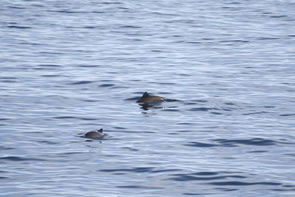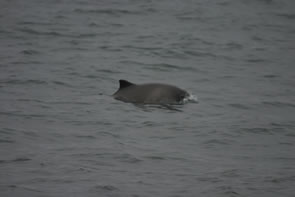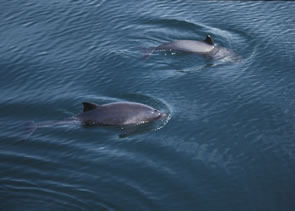Species Index


Key Facts
Length: Up to 1.8 metresRange: Coastal waters of North Atlantic and Pacific
Threats: Entanglement in fishing gear, habitat degradation
Diet: Variety of fish, shrimp and squid



Harbour Porpoise
Latin: Phocoena phocoena
Gaelic: Peileag
Physical Description
The harbour porpoise is the smallest of the cetacean species found in the Hebrides. Adult animals measure 1.4 to 1.7 metres in length and weigh around 68 kg. The body is fairly stocky and lacks a prominent beak. A triangular dorsal fin is positioned mid-body and is visible when the animal surfaces. Colouration is typically dark grey on the back and pectoral (side) fins, with lighter grey sides and a pale belly. Lifespan is about 10 to 20 years.
Habitat and Distribution
Worldwide, harbour porpoises are found in relatively inshore waters in the northern hemisphere. They are widespread throughout coastal regions of the Hebrides and are resident year-round. The number of harbour porpoises in Hebridean waters is amongst the highest in Europe. Current research is being carried out by HWDT in collaboration with St Andrew's University to determine the fine-scale habitat use of harbour porpoises off the west coast of Scotland.
Behaviour
Despite frequent sightings, harbour porpoises are normally seen only briefly when they surface to breathe. When they do surface, the blow is not normally visible but a puffing sound is often heard, earning this animal the nickname ‘puffing pig’. They are commonly seen in groups of two to five animals. Generally thought of as being quite elusive animals, harbour porpoises will rarely approach vessels and they are not known for aerial activity.
Food and Foraging
The harbour porpoise diet consists of over 20 different species of fish, squid, octopus and shellfish. Herring, sprat and sandeel makes up a large part of their diet in Hebridean waters. When feeding, they commonly surface to breathe about four times every 10 to 20 seconds before diving for up to six minutes. Teeth are small and spade-like, and are used to catch prey but not for chewing. They use echolocation clicks when exploring the surrounding environment, which are detected onboard Silurian using a towed hydrophone (underwater microphone). Killer whales are the main natural predator of harbour porpoises in the Hebrides.
Status and Conservation
Harbour porpoises are susceptible to being disturbed or killed by many human activities. Because of their feeding habits, they are at a high risk of entanglement in fishing gear. It is believed that several thousand may be entangled and drowned each year in UK waters, primarily in gill nets. Harbour porpoise distribution overlaps with areas of the coast that are most heavily used by people, which means they are exposed to high levels of shipping traffic, coastal development and other human sources of disturbance. Hearing is the most important sense for porpoises, but the loud underwater noises caused by vessels, military activity and seal scarers (Acoustic Deterrent Devices) used by some fish farms may impact on their distribution and welfare. Our boat-based research programme aims to develop an understanding of the most important habitats and the key habitat requirements for harbour porpoises in the region to help protect the species in the future. Harbour porpoises are protected under UK and EU law, principally under Schedule 5 of the Wildlife and Countryside Act 1981, the Nature Conservation (Scotland) Act 2004 and by the 1992 EU Habitats and Species Directive.





